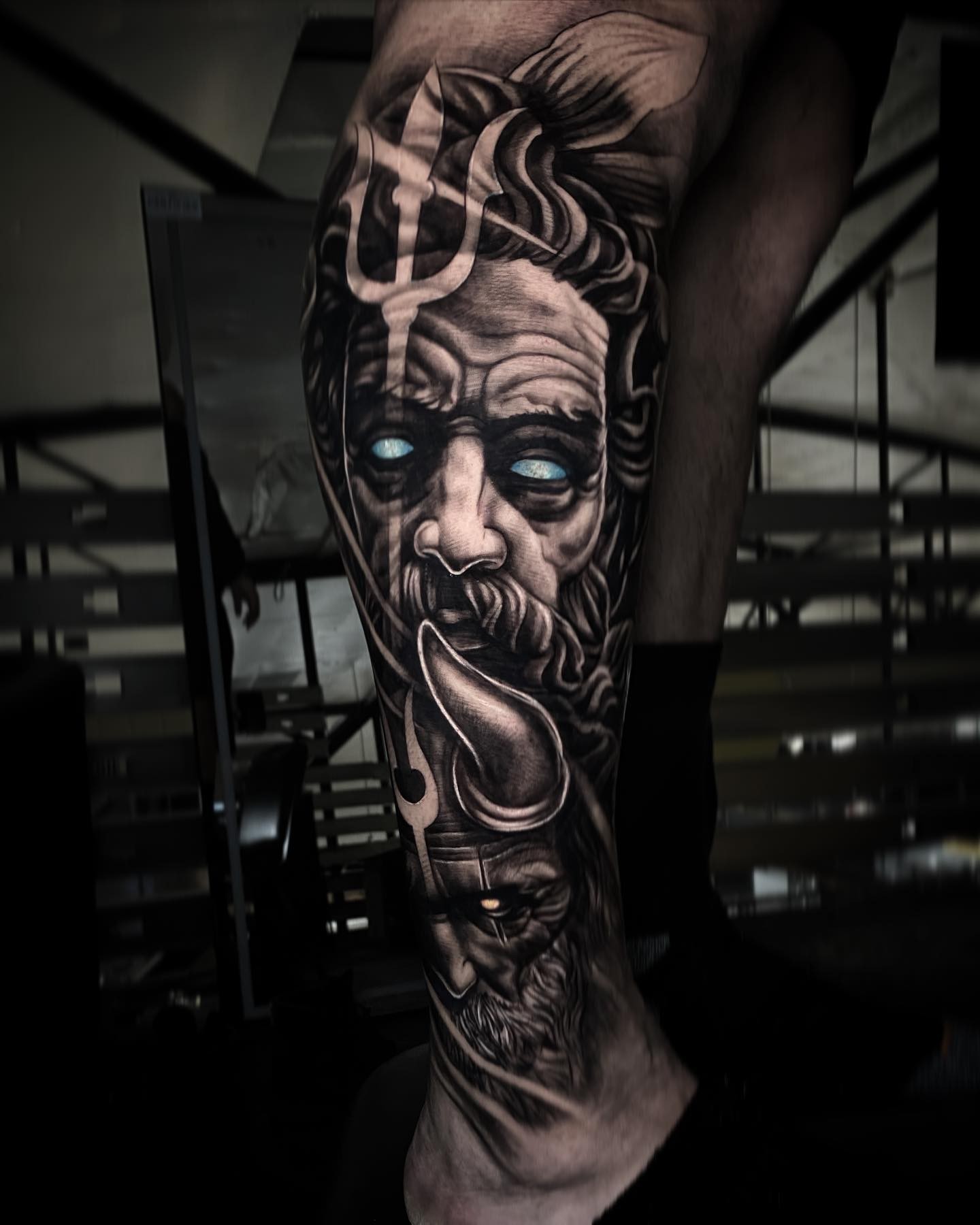Roman God Janus Tattoo
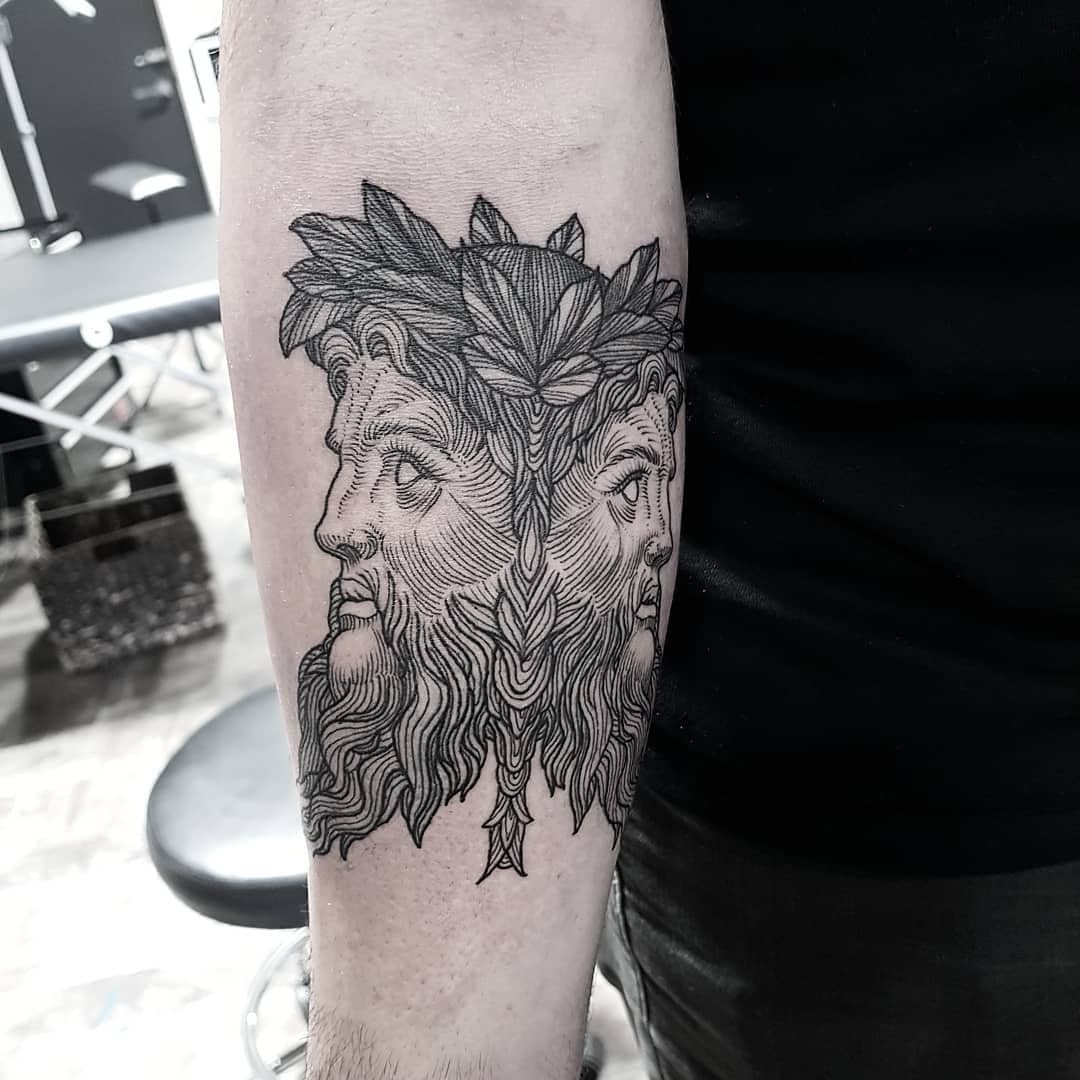
The Roman god Janus is renowned for his dual nature, embodied in the two faces that adorn his head. As the deity of new beginnings and endings, he symbolizes the cyclical nature of life, where every start marks an end. This multifaceted god also oversees gates, doorways, time, and transition, underscoring the idea that change is a perpetual force. In fact, January, the first month of the year, bears his name, serving as a reminder of the god’s omnipresence in our lives.
A striking forearm tattoo captures Janus’ essence, with two opposing faces rendered in black ink and fine lines by an accomplished artist. The design features long braided hair, a flowing beard, and a laurel wreath crown, while his eyes remain white orbs, devoid of pupils. Intricate dotwork and geometric patterns add depth to the piece, emphasizing Janus’ role as a harbinger of life’s dualities.
As such, this tattoo serves as a poignant reminder that every ending marks a new beginning, making it an attractive option for those seeking a meaningful ink.
Roman God Of War Tattoo
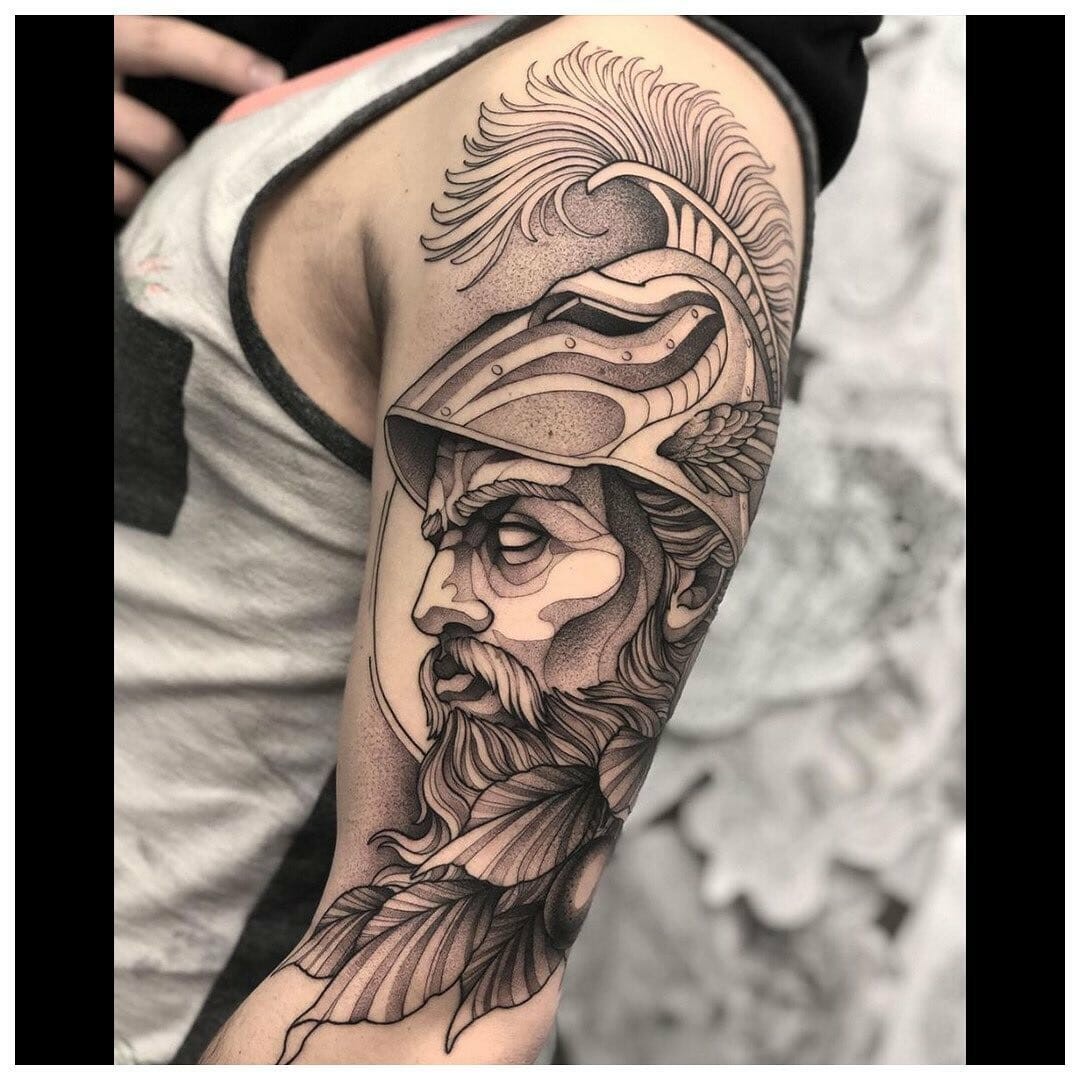
Mars, the Roman God of War, was born to Juno and Jupiter. As the most prominent deity with military experience, he commanded respect. According to ancient mythology, Mars owned a chariot pulled by two horses, Phobos and Deimos. His offspring included Cupid, the God of Love, as well as Romulus and Remus, the founders of modern-day Rome. This Roman god embodies peace, protection, power, and strength, making him a popular symbol in various forms, including War tattoos.
Mars’ involvement in the famous Trojan War only adds to his allure. For those eager to don a Roman God Mars tattoo, we offer an exemplary design. The artist’s rendition features an aggressive-faced Mars on the upper arm, crafted with black ink. A heart-shaped armor, reminiscent of ancient Roman military attire, adorns his chest. His long beard is framed by leaves, while dark and light shading brings depth to his facial features.
Roman God Of Fire Tattoo
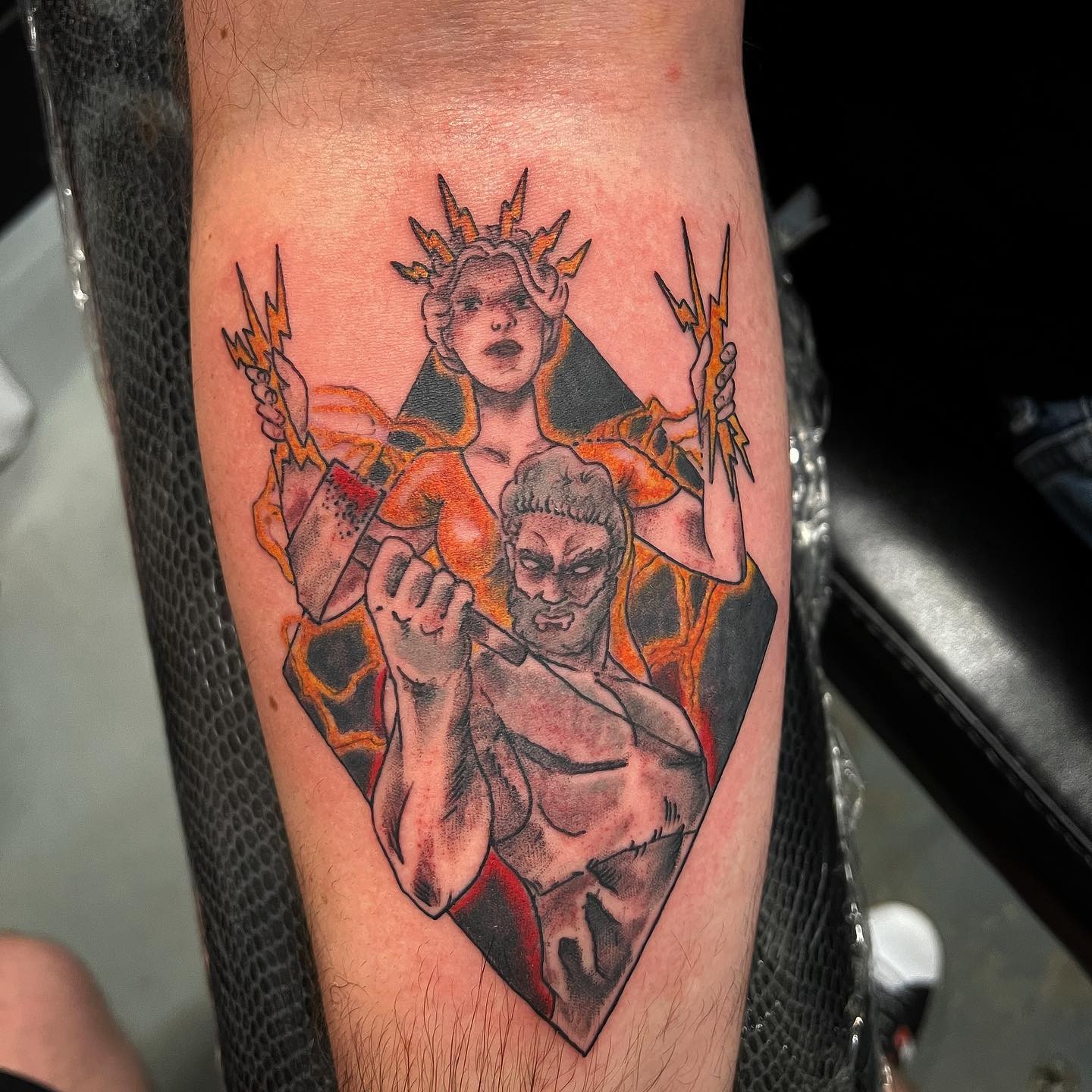
In ancient Roman mythology, Vulcan, the God of Fire, dwells beneath volcanic islands. His Greek counterpart, Hephaestus, was the son of Jupiter or Zeus, and his consort was Venus, also known as Aphrodite in Greek mythology. This divine blacksmith was renowned for his wisdom and cunning. The blacksmith’s hammer is a prominent symbol of Vulcan, often depicted in art and literature.
As a meaningful tattoo design, Hephaestus or Vulcan tattoos can feature the god holding a hammer, with Electra standing behind him, surrounded by lightning bolts. The artist has skillfully used contrasting ink colors, with Vulcan’s body rendered in black and Electra’s figure highlighted in orange. This unique tattoo piece exudes elegance and sophistication.
Roman God Jupiter Tattoo
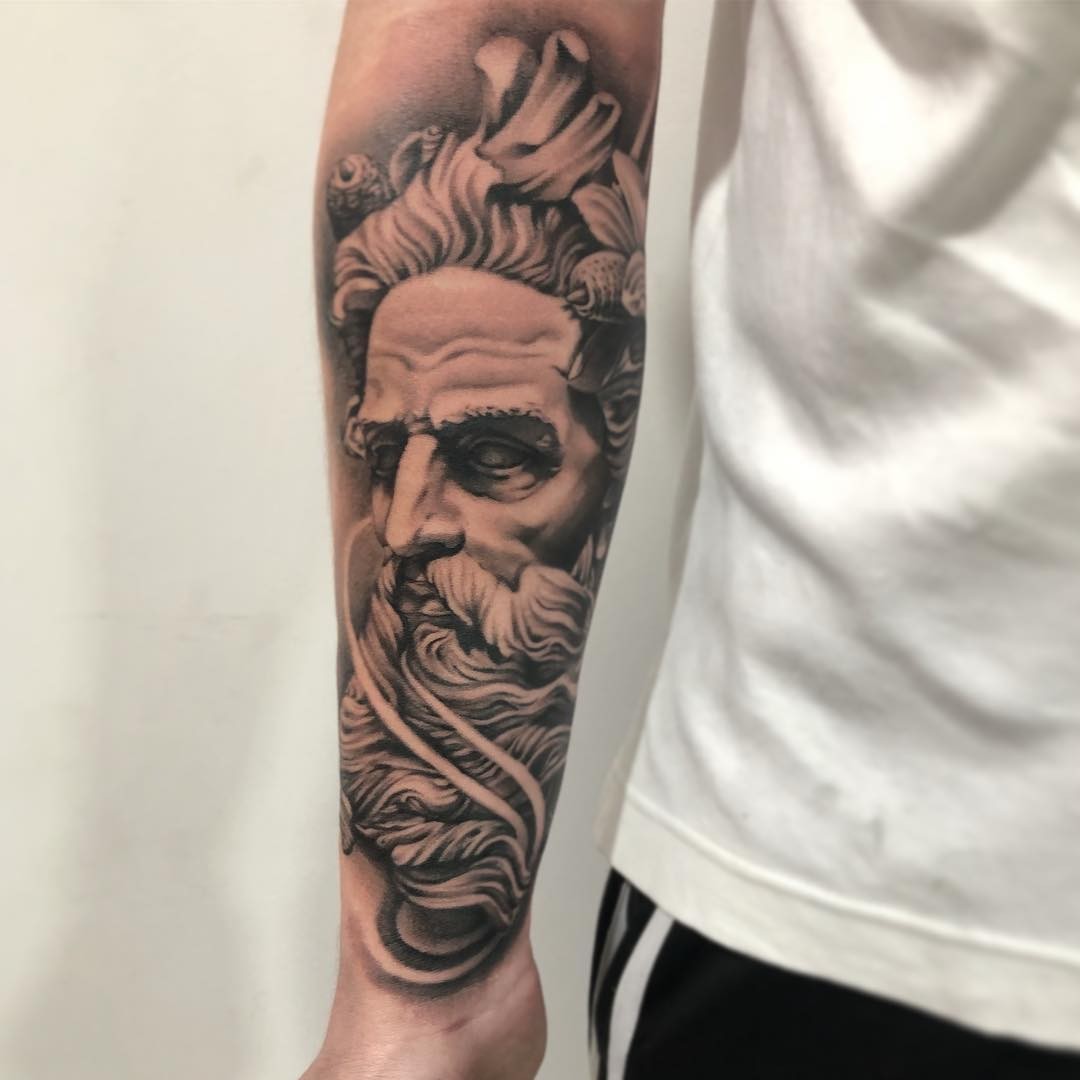
Jupiter, the ancient Roman deity, is often equated with the Greek God Zeus, who resided on Mount Olympus. As the God of thunder and the sky, Jupiter wielded significant power, earning him the title of King of the gods. This mythological distinction is mirrored in Greek mythology, where Zeus occupied a similar position. In addition to his thunderous domain, Jupiter is also known by his Roman alias, Jove.
The intricately detailed face that appears on this arm piece showcases Jupiter’s visage, with long hair and beard rendered in subtle shades of grey and black. His expressive features are characterized by prominent forehead lines and well-defined cheek muscles. Tattoos of Jupiter often symbolize protection, authority, good fortune, and a wealth of experience.
It is no surprise that both Jupiter and Zeus tattoos remain popular choices among individuals seeking to adorn their bodies with meaningful and powerful designs.
Apollo Tattoos
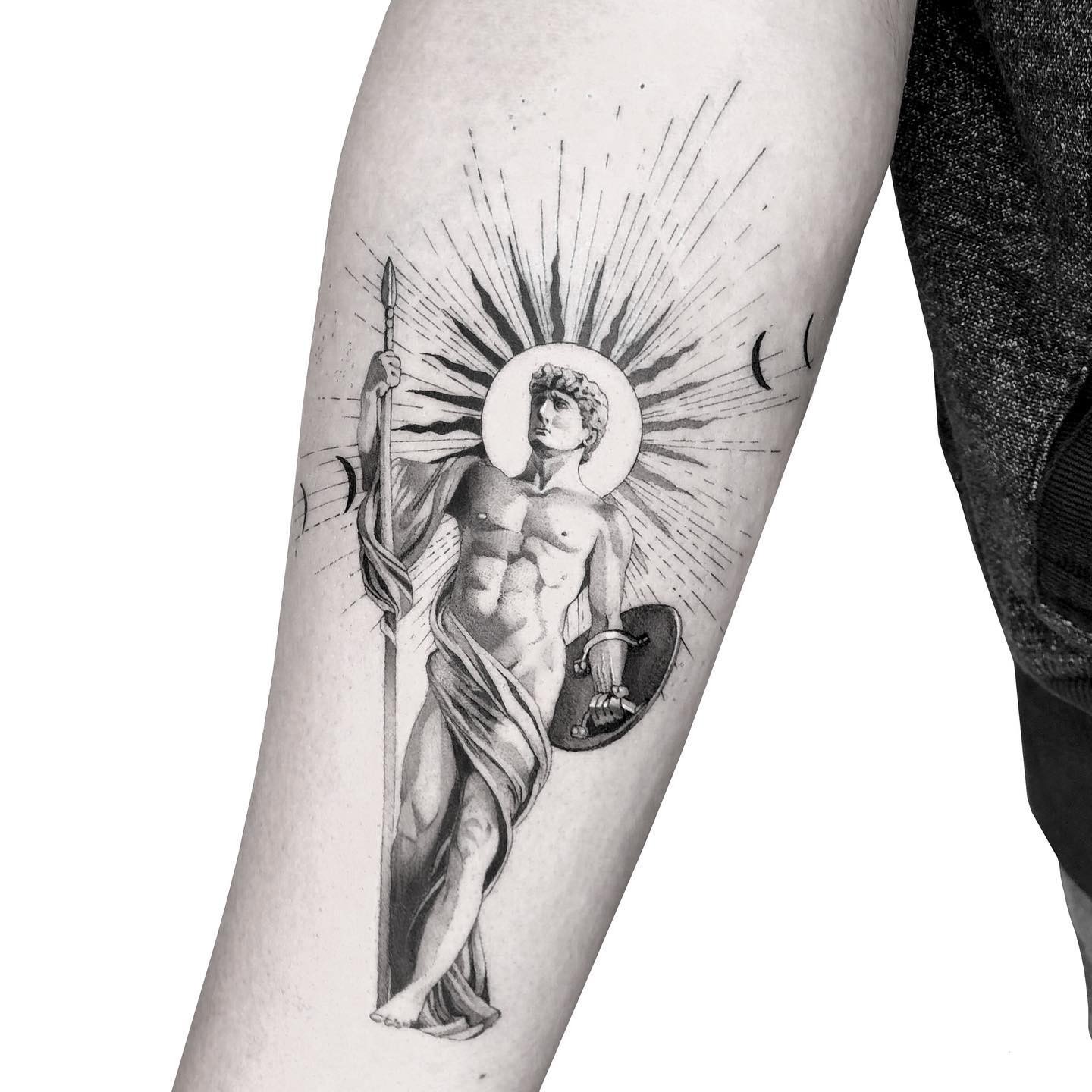
Apollo, the Roman Sun God, was an oracular deity revered for his divine connections to light, poetry, music, dance, diseases, and healing. As the son of Zeus in Greek mythology, he is often depicted as a young man with short hair, adorned with minimal attire that leaves little to the imagination. In this striking sleeve tattoo design, Apollo’s entire figure is intricately inked, showcasing his bold physique and radiant aura.
A shining sun, representing his celestial domain, serves as a stunning backdrop to the artwork. He wields both a shield and a long arrow, signifying his power and authority. This unique tattoo design embodies the essence of mythology, making it an exceptional choice for those seeking distinctive body art.
Roman God Sleeve Tattoo
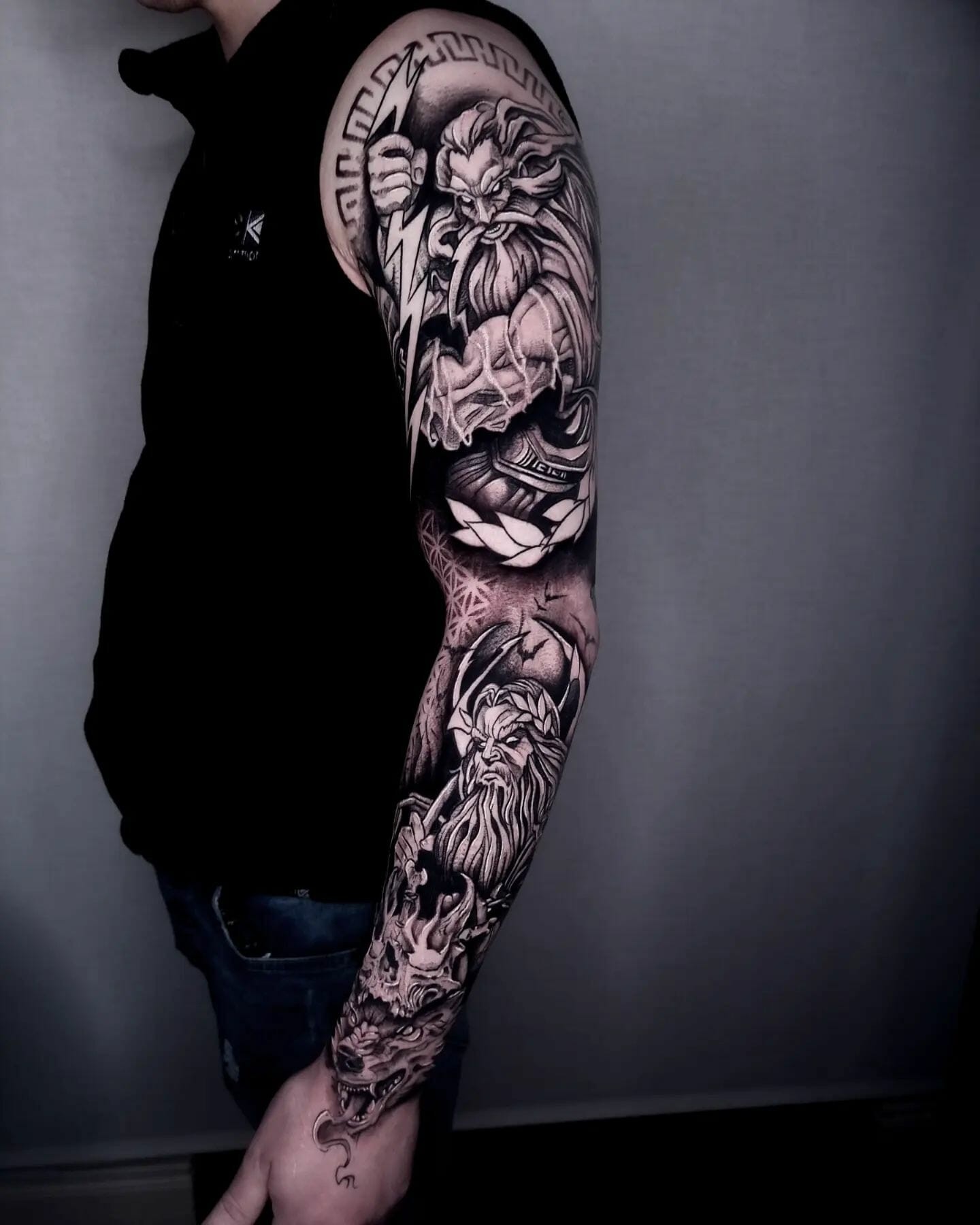
A striking sleeve tattoo features two powerful Roman deities, expertly rendered by the artist. At its apex, Jupiter reigns supreme, his iconic thunderbolts at the ready. Below, Pluto holds court alongside Cerberus, the three-headed hound of Hades. The entire piece has been executed in bold black ink, imbuing it with a sense of strength and intensity that would be equally at home on the arm of a confident individual.
Medusa Tattoos
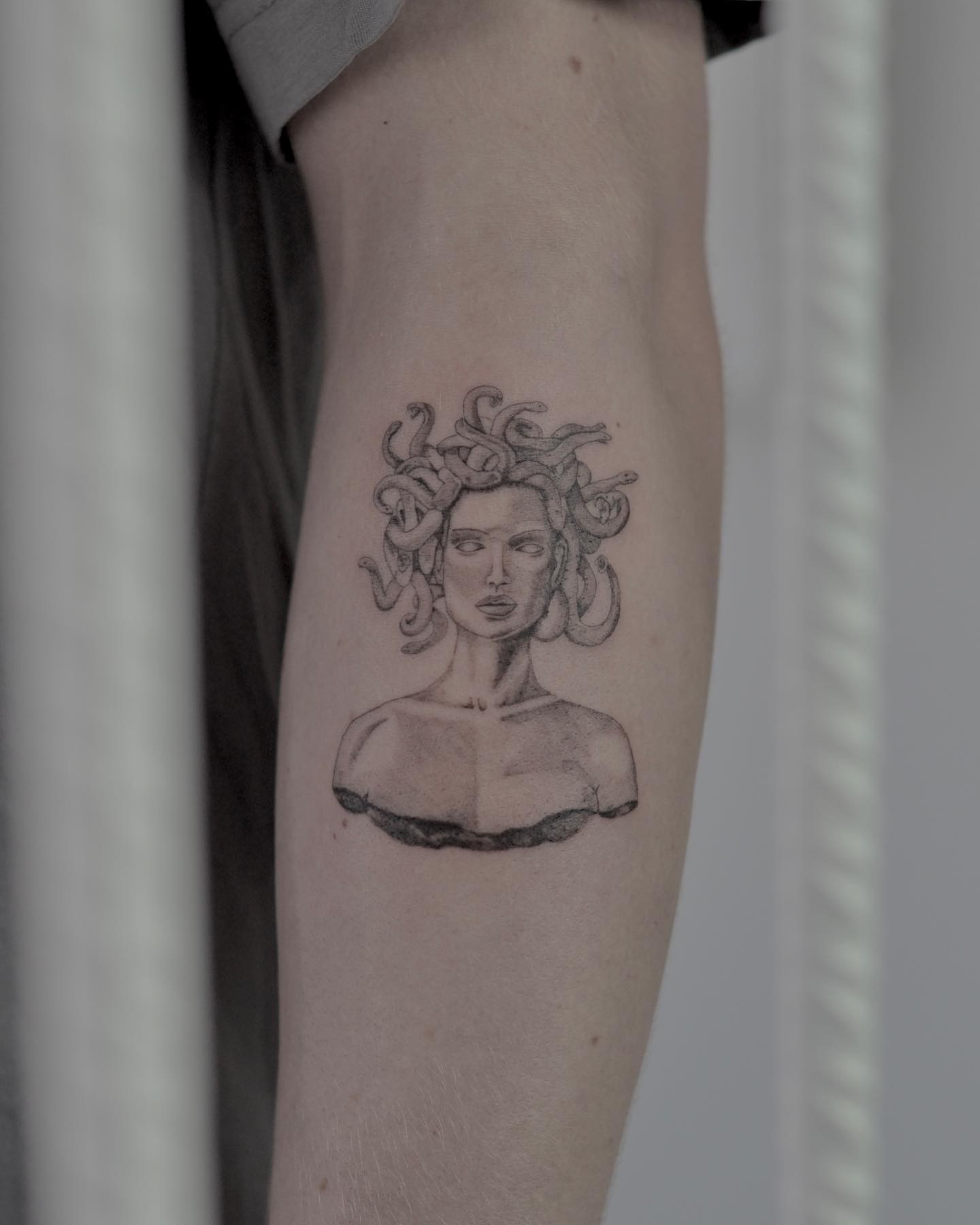
In Roman mythology, Medusa is an iconic creature with a reputation for turning those who gaze upon her to stone. Her story began as that of a beautiful woman, but a curse from Goddess Athena transformed her into the venomous serpent-haired monster we know today. As an apotropaic symbol, Medusa tattoos serve as a protective measure against negative energy and evil influences.
One unique design features Medusa as a normal woman with snakes covering her head, her fierce expression serving as a counterbalance to her monstrous form. The design only spans half of the arm, making it a striking yet subtle choice for those seeking protection from harm. Alternatively, for a bold statement piece, consider a back tattoo featuring Pluto’s face, accompanied by his characteristic three-headed dog and weapon.
This design showcases Pluto with flowing locks and beard, his empty eye sockets a haunting reminder of his otherworldly nature. A scar above his right eye adds an air of intensity to the overall piece, making it a compelling choice for those seeking to make a powerful statement.
Roman God Mercury Tattoo
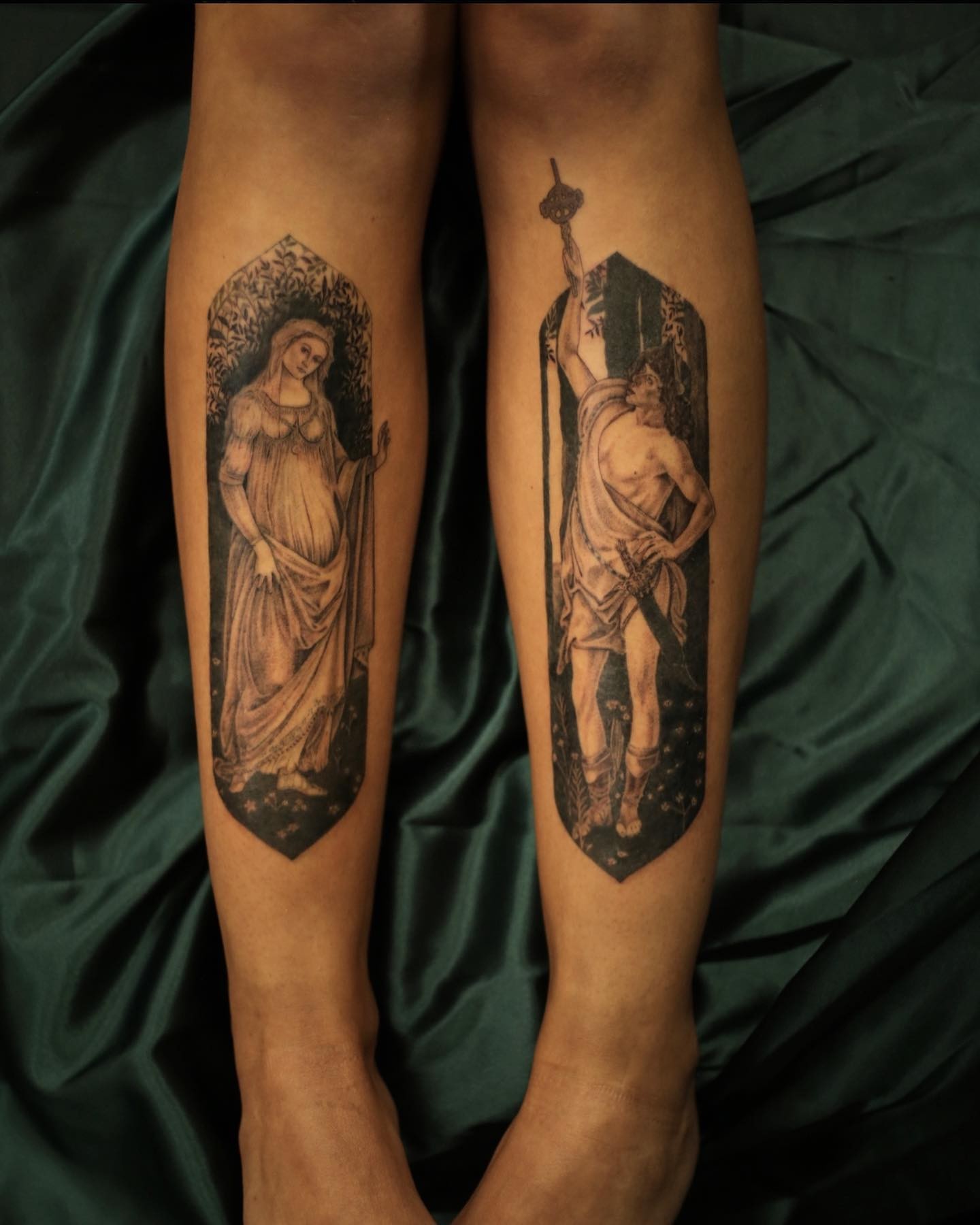
Roman god Mercury, patron deity of travelers, thieves, tricksters, shopkeepers, and merchants, has a counterpart in Greek mythology with Hermes, the Messenger God. In a nod to this divine heritage, the planet Mercury bears his name. This tattoo design is a stunning representation of Mercury’s persona, featuring two separate designs on each leg.
The right leg showcases the Mercury Tattoo, with the god donning loose attire and footwear while sporting a sword at his waist and holding aloft the caduceus in his left arm. His youthful appearance is evident from the contours of his face. The serene natural and floral backdrop only adds to the beauty of this tattoo. On the opposing leg, a tattoo of Venus, Goddess of beauty and luxury, takes center stage. Her Greek equivalent, Aphrodite, shares a similar mythological significance.
Roman God Of Death Tattoo
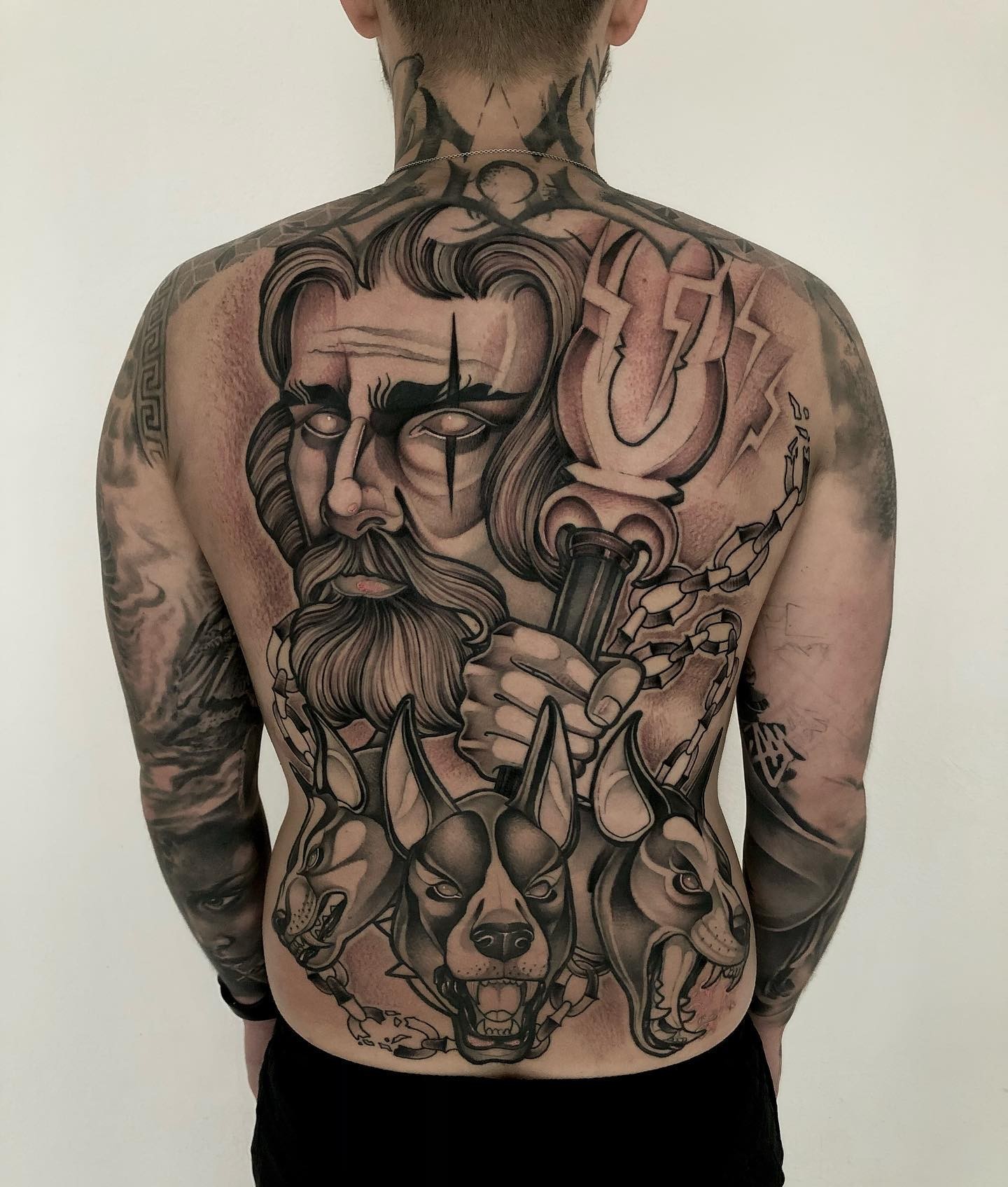
In Roman mythology, Pluto, also known as Hades in Greek culture, assumes the role of God of Death. He resides alongside his wife Persephone in the underworld. The connotations surrounding Pluto tattoos or Hades tattoos are often positive, reflecting a connection to the afterlife. This larger-than-life design features intricate details that set it apart from smaller designs prevalent in the tattoo industry.
Specifically, this back tattoo showcases Pluto’s visage, characterized by a stoic expression, absent eyeballs, and a scar above his right eye. His long locks and beard add texture to the design. In one hand, he holds his signature bident, resembling a pitchfork, while in the other, he cradles Cerberus – a three-headed canine and loyal pet that guards the gates of the Underworld. A broken chain wraps around Cerberus, further emphasizing the tattoo’s level of detail.
Roman Sea God Tattoo
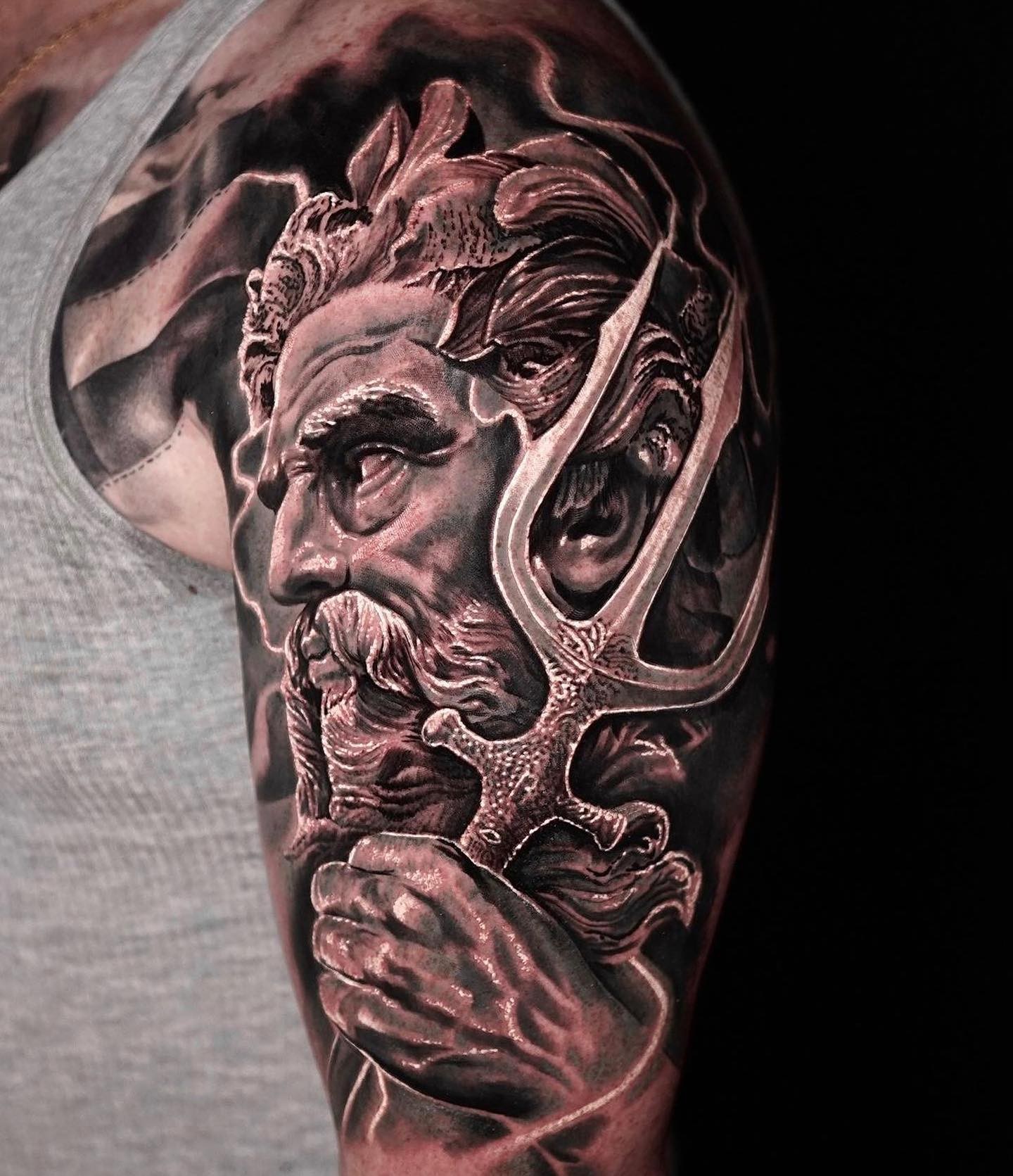
In the realm of mythology, Neptune, also known as Poseidon in Greek lore, reigns supreme as the sea god. His domain is the ocean, where he’s often depicted with symbols such as horses, dolphins, and tridents. This majestic deity has inspired numerous tattoo designs, with Neptune tattoos or Poseidon tattoos being a popular choice among enthusiasts. Our curated selection features an exceptional design that showcases Neptune’s visage on the upper arm, accompanied by his trusty trident.
The intricate details of his beard and locks, shaped like sea waves, serve as a powerful reminder of his kingship over the seas. While this list focuses on Neptune-inspired designs, fans of Roman mythology may also appreciate our collection of God tattoos, including Minerva Or Athena Tattoos, Roman Sun God Tattoo, Roman God Solar System Tattoo, Sylvanus Roman God Tattoo, and Roman God Pluto Tattoo. For further inspiration, readers may enjoy our blog post on Greek Goddesses Tattoo.
What is the meaning of a Roman god tattoo?
For many, a Roman god tattoo represents a powerful way to express their faith, spirituality, and cultural identity. By immortalizing an image of a deity from ancient Roman mythology on their skin, individuals can commemorate their beliefs or pay tribute to a loved one who has passed away.
These tattoos can be striking in their simplicity, featuring just the iconic visage of a god like Jupiter or Venus, or they can be elaborate compositions that incorporate symbols and motifs associated with the deity. Whether it’s to honor a personal connection to one’s heritage or to make a bold statement about one’s values, Roman god tattoos often carry significant emotional resonance for those who wear them.
What are some popular Roman god tattoos?
When it comes to Roman god tattoos, certain deities stand out for their enduring popularity. Among them are Jupiter, the supreme ruler and protector of Rome; Mars, the fierce warrior god; Janus, a unique figure with two faces, symbolizing beginnings and endings; Mercury, the swift and agile messenger god; Venus, the goddess of love and beauty; Apollo, the radiant deity associated with light and prophecy; and Neptune, the mighty ruler of the sea.
These gods are often accompanied by distinctive symbols that can add depth and meaning to Roman god tattoos, such as tridents, laurel wreaths, and Pegasus, a mythical winged horse said to carry the souls of the dead to the afterlife.
What is the significance of a Roman god tattoo?
A Roman god tattoo is a complex symbol that can hold various meanings for its wearer. On one hand, it may serve as a representation of faith or spirituality, reflecting an individual’s deeply held beliefs. On the other hand, the tattoo could be a means of honoring one’s cultural heritage or paying tribute to a lost loved one. Furthermore, some people perceive these tattoos as a way to embody power and strength, qualities often linked with the gods from ancient Rome.
The versatility of this design allows it to be interpreted in multiple ways, making it a unique and personal form of self-expression.
